Elevator pitch
In many countries, the wage floors and working conditions set in collective contracts negotiated by a subset of employers and unions are subsequently extended to all employees in an industry. Those extensions ensure common working conditions within the industry, mitigate wage inequality, and reduce gender wage gaps. However, little is known about the so-called bite of collective contracts and whether they limit wage adjustments for all workers. Evidence suggests that collective contract benefits come at the cost of reduced employment levels, though typically only for workers earning close to the wage floors.
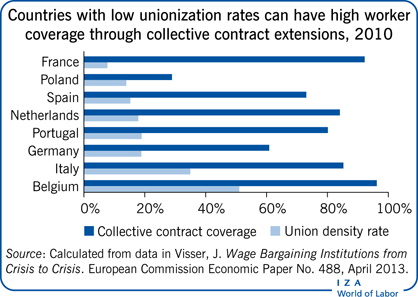
Key findings
Pros
The extension of collective contract provisions reduces wage inequality by setting occupation-specific minimum wages within an industry.
Collective contract extensions reduce gender wage gaps, mainly at the bottom of the wage distribution.
Collective contract extensions provide job stayers with partial insurance against transitory productivity fluctuations or economy-wide fluctuations associated with the business cycle.
In the absence of full mobility across jobs, collective contract extensions avoid opportunistic cuts in job quality and wages.
Cons
Sector-wide minimum wages increase labor costs to all covered firms, inhibiting employment growth.
Collective contract extensions impose working conditions on employers and employees who did not participate in the bargaining process.
Extending collective contracts reduces competition by deterring firm entry and small business creation.
Collective contract extensions introduce wage rigidities among workers close to wage floors, which may limit the ability of firms to adapt to economic shocks.
Author's main message
The overall impact of extending a collective contract to all firms in an industry depends on how much employment is lost due to the contract's provisions on minimum wages and other working conditions. Assessing the impact of collective contract extensions on wages and employment outcomes requires linking information on collective contracts registers to longitudinal data on employers and employees. New evidence based on such data sheds light on the so-called bite of negotiated minimum wage floors and shows that wage and employment responses are mostly confined to workers with earnings close to the minima. Policy mechanisms such as representation requirements and “opt-out” clauses may alleviate these concerns in some settings.
Motivation
Collective contracts regulate the working conditions of unionized and non-unionized workers around the world. Even in countries with low unionization rates, a large proportion of workers is covered by collective contracts through so-called extensions, in which the working conditions set by a group of employers and employees in an industry or region become binding for all employees and employers.
Collective bargaining contracts reached by a set of employers and employees in an industry or region become binding for all employees and employers in one of three ways: when a public authority, under authority of law, declares the contract binding; when a firm in one region adopts a collective contract signed in another region; or when a firm granted a public contract is required to adopt a collective contract as part of the contract. This article focuses on the first form of extensions, which are common in France, Germany, the Netherlands, Portugal, South Africa, and Spain, among other countries. It also considers Italy, where extensions are not mandatory but labor courts discretionally identify the “fair wage” level using the pay scales set in the sectoral collective contracts.
Both employers and employees profit from extensions. Setting minimum negotiated wage floors provides employees with some insurance against productivity fluctuations in their firms. Workers in a society with a concentrated distribution of skills and high firing costs prefer wages set in collective contracts to a situation with flexible wages [1]. Employers may also benefit from imposing high negotiated wages on all workers, because the resulting increase in costs deters small firms from entering the market. However, these gains can come at the cost of excluding low-skill individuals from the labor market.
It is not surprising then that extensions have been at the center of recent policy reforms in southern Europe. Reformers stress the adverse impact on employment, while defenders argue that extensions play a crucial role in maintaining workers’ income levels and avoiding wage inequality. It is thus worthwhile to review recent evidence that quantifies the bite (i.e. the share of workers whose earnings are close to the wage floors) and the impact on employment and wages due to collective contracts.
Discussion of pros and cons
The bite of collective contracts: Cross-country evidence
Until recently, the link between workers’ wages and wage floors set by collective agreements was not well known, mainly due to the lack of data. However, recent studies using hand-collected data shed light on the exact bite of collective contracts.
A first issue to consider is whether and to what extent wage floors are binding. Studies that link worker-level information from Social Security records to wage floors negotiated in extended collective contracts find only a limited degree of non-compliance [2], [3], [4], suggesting that those negotiated wage floors are effective minimum wages. A challenge to that view comes from the use of survey data in Italy or Spain, where some studies report high levels of non-compliance ranging between 8% and 29% [5], [6]. However, reporting error in the sources used and a lack of precise information to construct the corresponding wage floor introduces some nuances in those estimates of slippage.
A second piece of evidence regarding the relevance of wage floors is the “wage cushion,” that is, the percentage difference between the actual earnings of an employee and the corresponding floor set in the collective contract [4], [7]. Evidence suggests that the mean cushion is between 20 and 50 percentage points (Figure 1). This implies that even among workers covered by a collective contract, a substantial part of their pay depends on components other than wage floors.
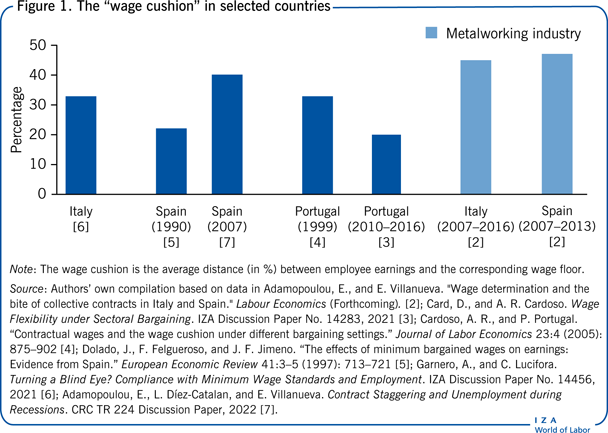
However, the magnitude of the wage cushion may not be completely informative if increases in negotiated floors affect the full distribution of earnings. For example, if upon contract renegotiation employers kept the full structure of earnings constant relative to negotiated wage floors, then a 1% increase in wage floors would increase actual earnings by 1% (i.e. there would be a full pass-through of wage floors to actual compensation). The opposite extreme case would occur if increases in wage floors resulted in a one-for-one reduction of other wage components, keeping total compensation constant. Thus, estimates of the pass-through are relevant to assess how binding collective contracts are. Figure 2 draws on various studies to estimate that, in a variety of countries and with various statistical techniques, a 1% increase in wage floors raises actual wages by between 0.3 and 0.5 on average, a long way from the full pass-through hypothesis. The response is relatively larger for wages close to the negotiated wage floors, suggesting that wage floors negotiated in collective contracts do have some spillover effects, but certainly fall short of shaping the full wage distribution.
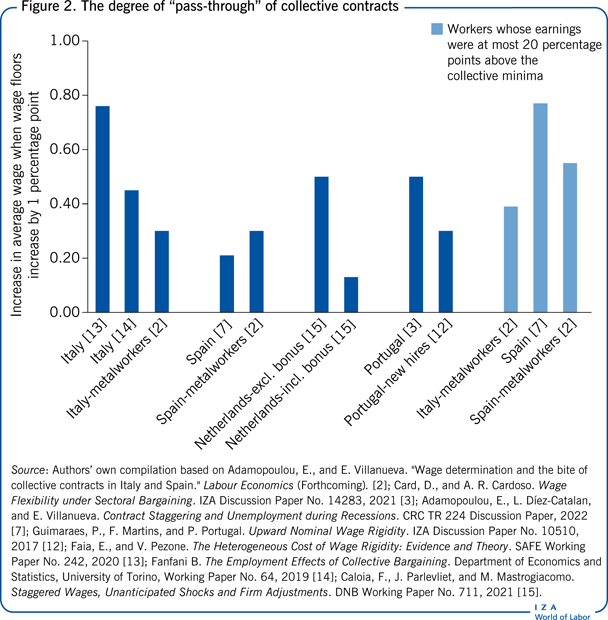
Benefits of collective contract extensions: Impacts on wage inequality
The evidence indicates that the extension of collective bargaining contracts imposes minimum wage requirements on all firms in an industry, and that, given the limited degree of spillover to other wages, those floors potentially compress the wage distribution and reduce inequality. A first indication of this compression can be obtained by examining the share of workers whose earnings are around the negotiated minimum wage. In Portugal, for example, the wages of females, youths, and of low-skilled workers are concentrated around negotiated minimum wages [3], [4]. There is similar evidence for the Italian and Spanish metalworking sectors; in both countries, workers in small firms and employees with low tenure are more likely to earn wages close to the negotiated minima [2].
Changes over time in the distribution of wages can reflect the coverage of collective contract extensions. Germany and Portugal experienced surges in wage inequality during the 1990s. About a quarter of the increase in wage inequality at the bottom of the wage distribution between 1995 and 2004 can be linked to the declining share of collective contract coverage in Germany [8]. In Portugal, extensions have not avoided an increase in wage earnings at the top of the distribution, but they have been important in insuring workers’ earnings against transitory fluctuations in firm-level productivity.
Another potential benefit of collective contract extensions is in narrowing wage differentials within occupations, in particular gender wage gaps. Particularly compelling evidence can be drawn from the experience in Wisconsin, in the US, where the replacement of collective bargaining for teachers by a flexible pay system that required individual bargaining led to a widening of the gender wage gap. The main reason is that female teachers, especially those who are young and with few years of experience, are less likely to negotiate overpay than males [9]. Similar evidence is available in the Netherlands and in Spain. In sum, the evidence confirms that the extension of collective contracts lessens wage inequality within and across occupations.
The cost of collective contract extensions: Impacts on employment
At the aggregate level, countries with larger gaps between union density and collective contracts, that is, with “excess coverage” (Figure 3), do not generally have higher unemployment rates.
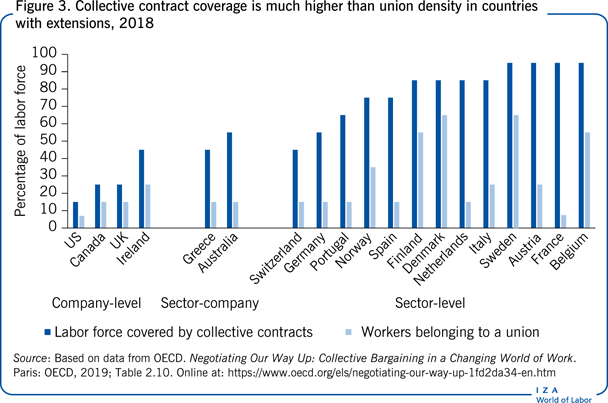
However, broad measures at the country level may reflect other factors than simply the automatic extension of collective contracts. In Germany, for example, non-unionized workers can be covered by collective contracts through a firm's voluntary adoption of collective contracts. A closer look at country-specific cases thus offers additional insights into how collective bargaining contract extensions work.
The extension of collective contracts to firms that did not negotiate the agreement reduces employment
Similar to some European countries, in South Africa collectively bargained union contracts are binding for all employers within the industry and regions covered by the applicable bargaining council. Bargaining councils in South Africa are organizations formed by unions and employer federations to negotiate collective agreements and resolve labor disputes. Most bargaining councils represent groupings of the 354 magisterial districts that map to political boundaries. Following the extension of a collective contract, employment levels in firms covered by a bargaining council fell 10% while (quality adjusted) wages rose 10–15%, relative to adjacent councils [10]. Furthermore, relative to the border between areas covered and not covered by an extension of the collective contract, the rate of business creation was larger on the side of the border where the collective contract was not extended.
Information about the timing of extensions provides additional insights about how firms adjust to changes in labor conditions. A striking case is that of Portugal, where the extension of working conditions in collective contracts happens well after the original contract is signed. The delay in implementation of a contract enables researchers to examine what happens to the number of workers employed in firms affected by collective contract extensions in the period immediately before and after the extension. A comparison of employment in industries subject to an extension and in similar industries not subject to an extension during an eight-month window finds that employment fell by about 2 percentage points in the month in which a collective contract was formally extended to firms in an industry [11].
In addition to wages, collective contracts regulate working conditions that may affect labor costs, such as number of holidays, overtime, and night shift pay. Some contracts also specify which workers can do which jobs, further constraining the reallocation of labor within a firm. A useful strategy for isolating the role of binding negotiated wages is to identify firms with a substantial share of employees whose wages fall below the new minimum. The use of matched data on employers, employees, and collective contracts between 1986 and 2009 in Portugal suggests that dismissals increase and hirings freeze after the extension of a bargained contract and that these effects are concentrated precisely among firms that experience the largest increases in labor costs [11].
The working conditions imposed by a collective contract extension could be especially stringent for small firms, whose views may not be reflected in the bargaining process. The evidence for Portugal suggests that small firms affected by an extension experienced employment losses of 2.6%, compared with an overall drop of 2% [12]. Similar results are found for South Africa, where employment losses were confined to firms with fewer than ten employees [10]. The evidence for both countries suggests that small firms cut employment more than other firms following the extension of a collective bargaining contract.
The extension of collective contracts amplifies aggregate shocks
Depending on the country, collective contracts can fix nominal wage increases for long periods of time. This means that if inflation turns out to be much lower than expected, real labor costs in firms that have already signed long-term contracts will rise by a comparatively large amount, because nominal wages cannot be lowered under the existing contract (wages are downwardly rigid). Likewise, the opposite effect can occur if inflation is greater than expected. In contrast, collective contracts that are signed after actual inflation is observed can adjust to the new situation. The empirical relevance of that mechanism has been explored in Canada where, when the increase in prices was larger than expected, manufacturing firms that had already signed union contracts expanded their employment levels more than comparable firms that signed union contracts after the increase in prices. Similarly, the wage rigidity induced by the timing and duration of collective contracts in Italy amplifies the effects of monetary policy on firms’ stock market valuations [13].
The extension of collective contracts to all firms in an industry implies that, at the onset of a recession, the wage growth of a large fraction of workers corresponds to expectations for wage growth during an economic expansion. The degree of nominal wage rigidity increases with the duration of collective contracts. For example, part of the sluggish reaction of aggregate wages in Spain at the onset of the Great Recession in 2008–2009 can be attributed to the influence of a substantial fraction of lengthy collective contracts signed during good times [7].
To understand how an aggregate shock propagates in a country where a large share of the labor force is covered by collective contract extensions, it is useful to consider a large and unexpected drop in economic activity, such as that following the bankruptcy of the financial services firm Lehman Brothers in 2008. In Spain, as expected, contracts signed immediately after the September 15, 2008, declaration of bankruptcy included wage increases that were 1 percentage point smaller than contracts signed immediately before that date. Similar developments occurred during the 1992 recession and the Covid-19 pandemic. Because of the regional nature of collective bargaining in Spain, the wage adjustment happened both within provinces and within industries. Labor market histories suggest that in 2010, two years after the fall of Lehman Brothers, workers who used to be employed by firms subject to high wage increase extensions still had a 1 percentage point higher chance of being unemployed than employees in other firms. The estimated chance of being unemployed roughly tripled among workers whose wages were close to the negotiated floors in 2007.
Comparing pros and cons: The responsiveness of employment growth to wage increases
The evidence reviewed thus far suggests that collective contract extensions reduce wage dispersion at the cost of some employment losses. Among employees who keep their job, the extension of collective contracts helps to maintain earnings to a certain degree. Income stability—even if it benefits only job stayers—is especially valuable during a recession. Still, this insurance is only partial, as most workers earn well above the minimum wage floors, and their cushion gets compressed during recessions [2], [3], [7].
The responsiveness (“elasticity”) of employment to an increase in labor cost is relevant when comparing the costs and benefits of a collective contract extension. If that elasticity is close to zero, the cost of collective contract extensions—the reduction in employment—would be small compared with the benefits of increased earnings among workers who keep their jobs. In that scenario, the total earnings received by those who remain employed might well rise as a result of contract extensions. If, however, the elasticity of employment to wage increases is close to –1, total nominal earnings would remain constant after the extension of the collective contract, as the extra earnings accrued by job stayers would be completely offset by the loss of earnings among displaced workers. A constant level of total earnings after an extension is likely to represent an actual loss in overall workers’ welfare, however, because €1 of earnings is arguably more valuable for a displaced worker than for a job stayer, especially when reallocation is costly.
The magnitude of the elasticity of labor demand to changes in labor costs varies much more across studies than the elasticity of actual wages to wage floors, previously reviewed in Figure 2. In Portugal, following the extension of a collective contract, the total payroll of affected firms drops an estimated 2%—an elasticity of –2. That estimate implies that downsizing is large enough to offset the increase in earnings among workers who keep their jobs. However, the true elasticity of labor demand to changes in the cost of labor is likely smaller, as firms may dismiss employees to hire additional workers using contractual forms not covered by collective contracts [11]. Taking into account the actual increase in labor costs associated with an extension and the associated changes in employment, as well as an exhaustive number of worker-level characteristics, the estimated elasticity of employment to wage costs in Portugal falls to about –0.30, or even becomes null [3].
However, examining a firm's employment level in isolation may be misleading because workers may be exiting shrinking firms to work in growing ones, which would leave total employment unaffected. A possible solution then is to examine how changes in wage floors affect employment outcomes in local labor markets. Experiments of that sort in Italy yield a high elasticity of employment to changes in labor cost, of about –0.8 [14].
In contrast, flows from employment to unemployment are indicative of a collective contract extension's effects on employees’ earnings in the medium term. In addition, the employee group of interest is workers whose wages are close to the new set of minimum wages established in the collective contract extension—the workers whose earnings collective contracts seek to preserve.
In Spain, the availability of data that match collective contract extensions with longitudinal information on workers enables researchers to compare working days lost between 2009 and 2010 by workers displaced by the collective contract extensions to the increase in wages among workers who retained their jobs [7]. Figure 4 shows the proportion of workers close to the minima who were not employed in each month between 2009 and 2010 and whose extended collective contract was signed before September 15, 2008 (the date of the Lehman Brothers bankruptcy declaration) relative to similar workers whose collective contract was signed after that date. Overall, the wage rigidity induced by the extension of collective contracts led workers subject to post-September 15 contracts to be 1.3% more likely to lose their job between 2009 and 2010 than workers subject to pre-September 15 contracts. The wage increase among job stayers with binding negotiated wages was between 1.3 and 1.7% [7]. A conclusion from this experiment is that for workers close to the minima, for whom the degree of pass-through is largest, a part of the wage gain during a severe recession was offset by job losses.
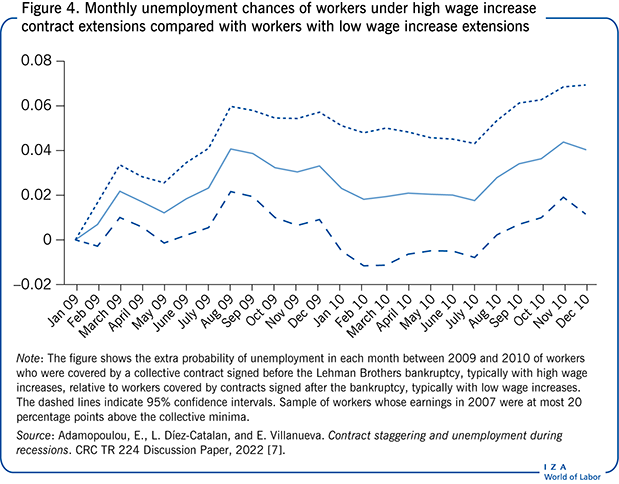
Interestingly, a similar exercise conducted in the Netherlands, a country where the pass-through is limited, points at very limited wage and employment responses to changes in wage floors around the same macroeconomic shock [15]. The lack of data on the wage cushion in that study precludes an analysis of whether the discrepancy of the results between Spain and the Netherlands is due to a feature of collective bargaining or, simply, to differences in the fraction of workers whose wages are close to the floors. This is an example of how the availability of matched data on wage floors and actual wages is crucial to learn about the consequences of different wage setting systems.
Limitations and gaps
Assessing the impact of collective contract extensions on wages and employment outcomes requires linking information on collective contracts to longitudinal data on employers and employees. Such data sets are not readily available in many of the countries where collective contract extensions are practiced. However, registers on collective contracts do exist, and matched employer–employee data sets are becoming increasingly available. Having data from more countries could then give a broader picture of the impact of alternative forms of extensions.
One unintended consequence of collective contract extensions is that firms may try to bypass their conditions through fake collective contracts (also called “pirate” agreements) or by shifting workers to nonstandard labor contracts, such as those under which many “service providers” in Portugal work. Where that is the case, it is no longer obvious how the extension of collective contracts affects the wage distribution of job stayers. Disentangling such effects is even more complex in economies with dual labor markets—labor markets where some workers with open-ended contracts are protected from dismissals by high severance payments whereas other workers have fixed-term contracts and are unprotected. Finally, industry- and occupation-specific minimum wages are likely to represent a barrier for potential entrants but may also discourage opportunistic wage cuts by monopsonistic employers. Estimating the impact of collective contract extensions on the entry of new firms or as a means of avoiding monopsonistic behavior are important avenues for further research.
Summary and policy advice
Collective contracts set minimum wage floors, whose bite is comparable to that of statutory minimum wages. Consequently, most workers have a cushion that acts as a margin of wage adjustment during recessions and as a way of counterbalancing increases in the negotiated wage floors. Extending collective contracts may entail some employment destruction, but mainly among workers whose wages are close to negotiated wage floors. Those empirical results do not imply that extensions should be stopped: collective contracts are extended to varying degrees in both Germany and the Netherlands, where employment levels have performed well during the Great Recession. These two countries have mandated minimum representativeness thresholds for collective contracts to be extended. However, the recent experience in Portugal calls for caution when introducing such criteria, as representativeness requirements were short-lived.
Another implication of the cost–benefit findings is the need to allow struggling firms to opt out temporarily from binding collective contracts until their position improves without resorting to pirate agreements. While opting-out (or opening) clauses are formally present in collective contracts in several countries, including Germany, the Netherlands, and Spain, there is limited evidence about their efficacy.
Finally, an important obstacle to concrete policy advice is the dearth of public and comprehensive data on wage floors in Continental Europe, let alone matched data on actual workers’ wages and the corresponding wage floors. Most studies surveyed here rely on hand-collected data by researchers on subsets of workers. Given the policy debate, the potential for a coordinated and systematic data collection is substantial.
Acknowledgments
The authors thank three anonymous referees and the IZA World of labor editors for many helpful suggestions on an earlier draft. All views are the authors’, and do not represent those of the Banco de España or the Eurosystem. Version 2 of the article contains two new figures and significantly updates the text and references based on new evidence around the bite of collective contracts.
Competing interests
The IZA World of Labor project is committed to the IZA Code of Conduct. The authors declare to have observed the principles outlined in the code.
© Effrosyni Adamopoulou and Ernesto Villanueva
Collective bargaining contract extensions: International examples
Source: Cardoso, A. R., and P. Portugal. “Contractual wages and the wage cushion under different bargaining settings.” Journal of Labor Economics 23:4 (2005): 875–902; Visser, J. Wage Bargaining Institutions from Crisis to Crisis. European Commission Economic Paper No. 488, April 2013.